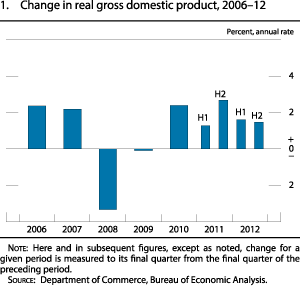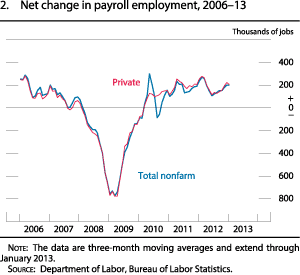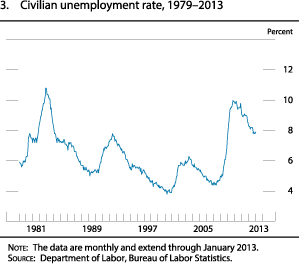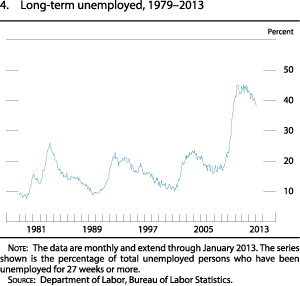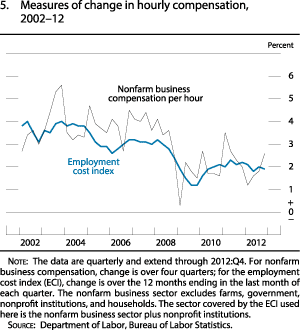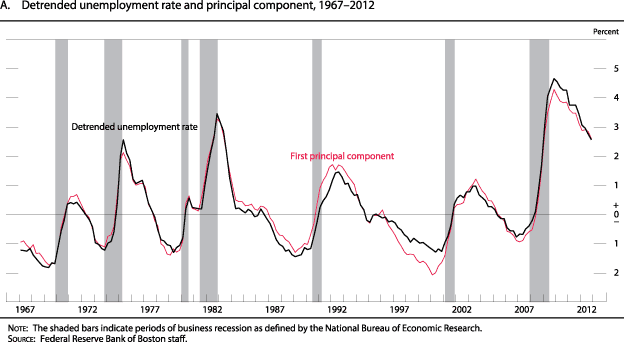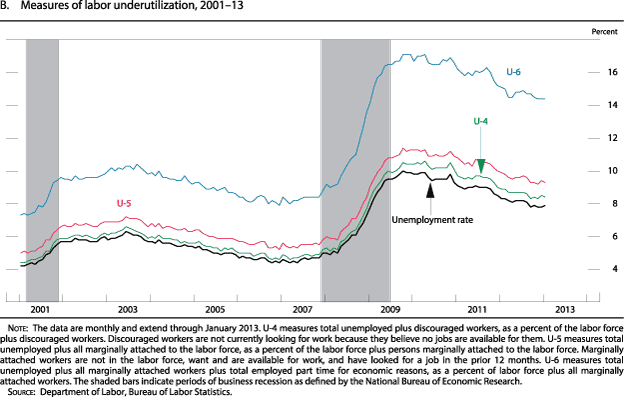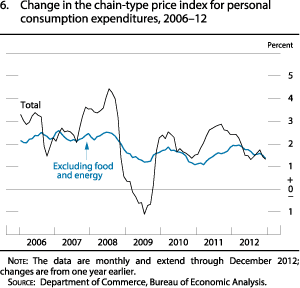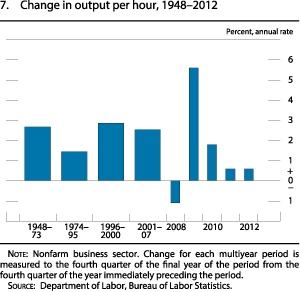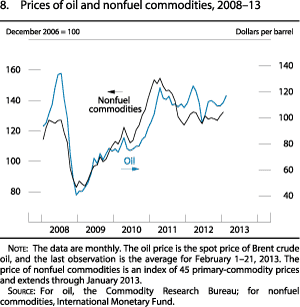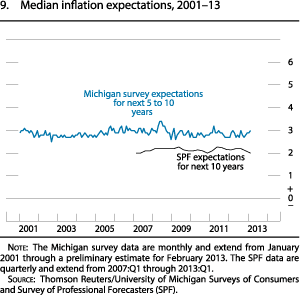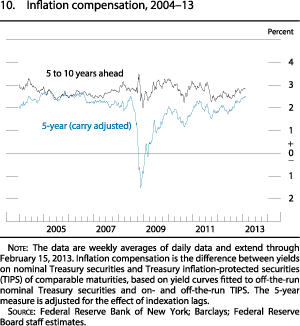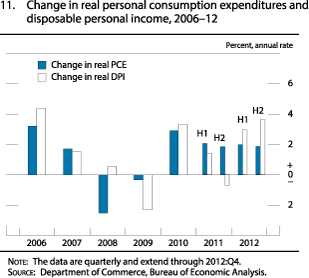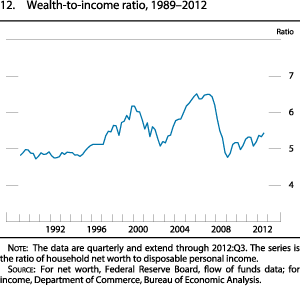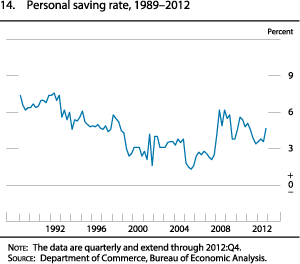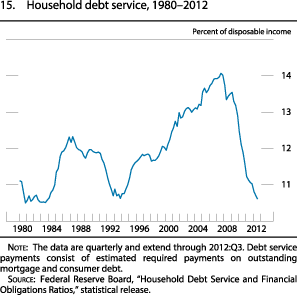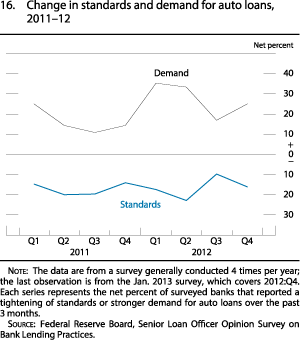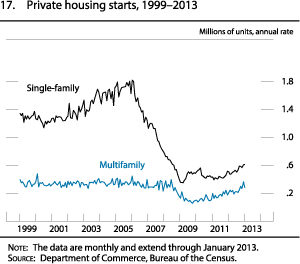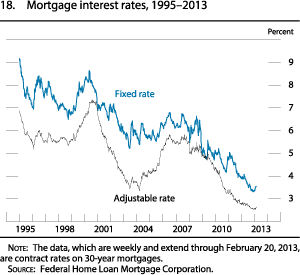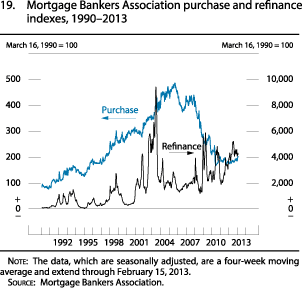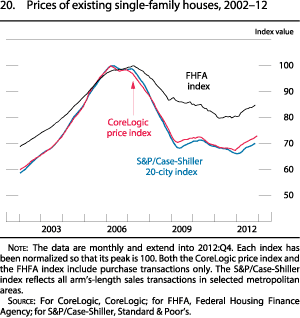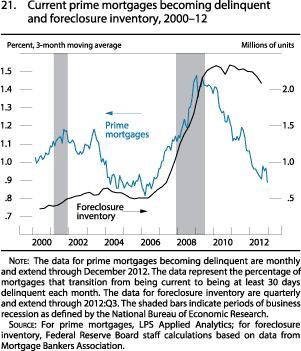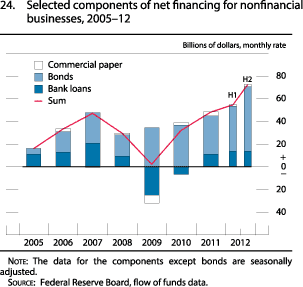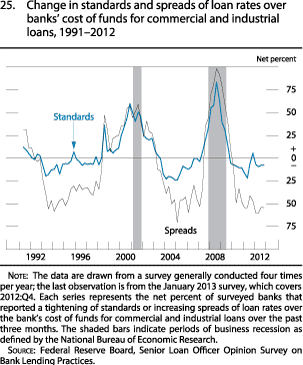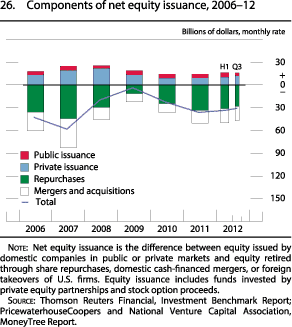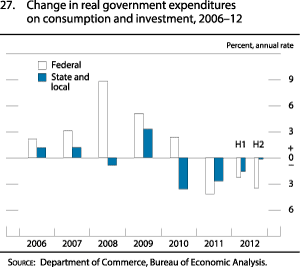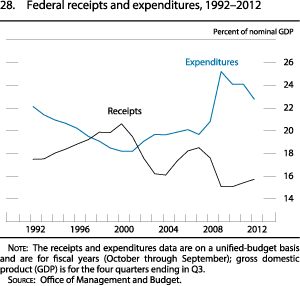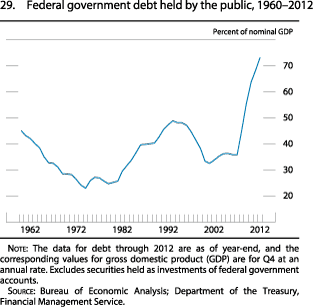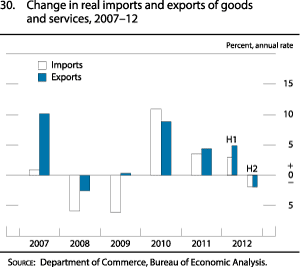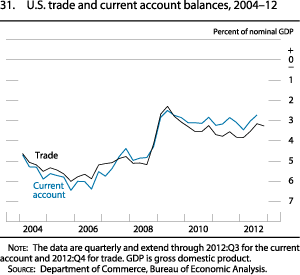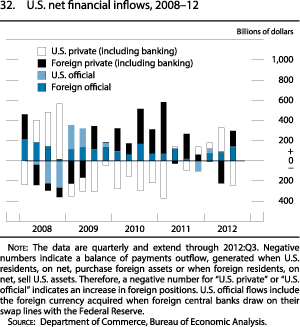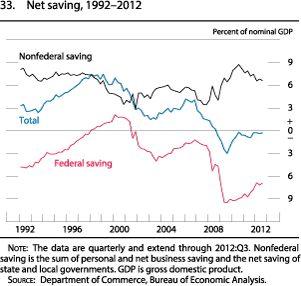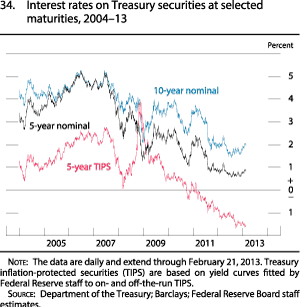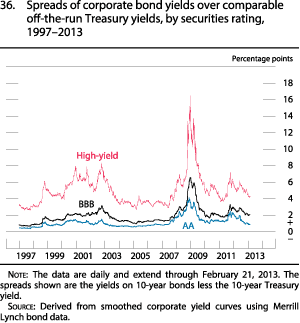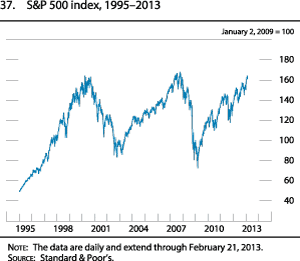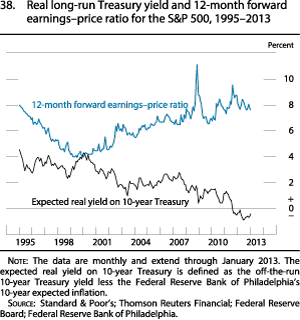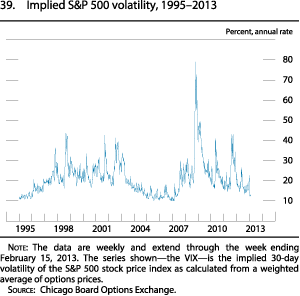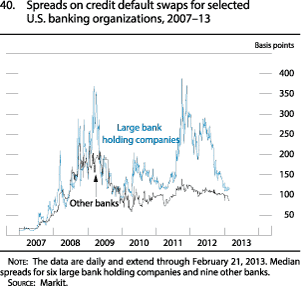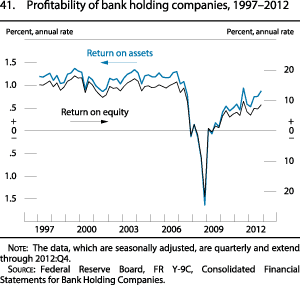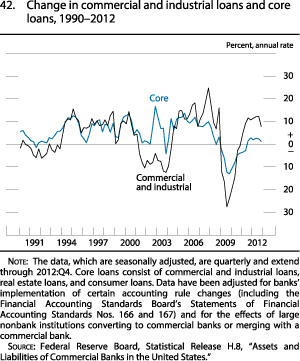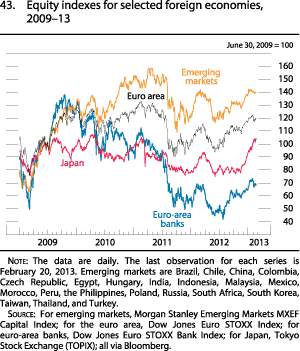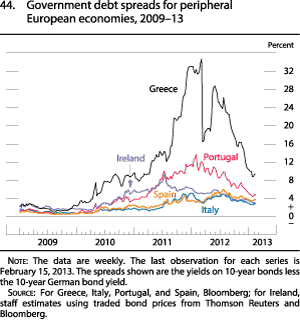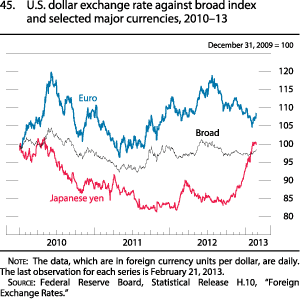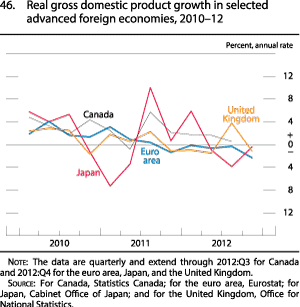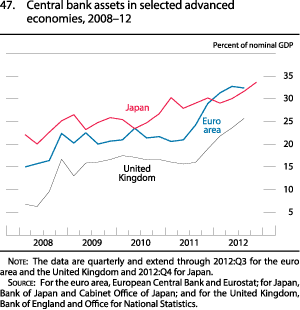- February 26, 2013: Summary
- Part 1
- Part 2
- Part 3
- Abbreviations
- Printable Version (1.1 MB PDF)

Sections of Part 1
Part 1: Recent Economic and Financial Developments
Monetary Policy Report submitted to the Congress on February 26, 2013, pursuant to section 2B of the Federal Reserve ActReal gross domestic product (GDP) increased at a moderate annual rate of 1-1/2 percent, on average, in the second half of 2012--similar to the rate of increase in the first half--as various headwinds continued to restrain growth. Financial conditions eased over the second half in response to the additional monetary accommodation provided by the Federal Open Market Committee (FOMC) and to improved sentiment regarding the crisis in Europe. However, credit availability remained tight for many households and businesses. In addition, declines in real government purchases continued to weigh on economic activity, as did household and business concerns about the economic outlook, while weak foreign demand restrained exports. In this environment, conditions in the labor market continued to improve gradually but remained weak. At a little under 8 percent in January, the unemployment rate was still well above levels prevailing prior to the recent recession. Inflation remained subdued at the end of last year, with consumer prices rising at about a 1-1/2 percent annual rate in the second half, and measures of longer-run inflation expectations remained in the narrow ranges seen over the past several years.
Domestic Developments
GDP increased moderately but continued to be restrained by various headwinds
Real GDP is estimated to have increased at an annual rate of 3 percent in the third quarter but to have been essentially flat in the fourth, as economic activity was temporarily restrained by weather-related disruptions and declines in some erratic categories of spending, including inventory investment and federal defense spending.1 On average, real GDP expanded at an annual rate of 1-1/2 percent in the second half of 2012, similar to the pace of increase in the first half of the year (figure 1). The housing recovery gained additional traction, consumer spending continued to increase moderately, and business investment rose further. However, a severe drought in much of the country held down farm production, and disruptions from Hurricane Sandy also likely held back economic activity somewhat in the fourth quarter. More fundamentally, some of the same factors that restrained growth in the first half of last year likely continued to weigh on activity. Although financial conditions continued to improve overall, the financial system has not fully recovered from the financial crisis, and banks remained cautious in their lending to many households and businesses. In particular, restricted financing for home mortgages and new-home construction projects, along with the depressing effects on housing demand of an uncertain outlook for house prices and jobs, kept the level of activity in the housing sector well below longer-run norms. Budgetary pressures at all levels of government also continued to weigh on GDP growth. Moreover, businesses and households remained concerned about many aspects of the economic environment, including the uncertain course of U.S. fiscal policy at the turn of the year as well as the still-worrisome European situation and the slow recovery more generally.
The labor market improved somewhat, but the unemployment rate remained high
In this economic environment, firms increased their workforces moderately. Over the second half of last year, nonfarm payroll employment rose an average of about 175,000 per month, similar to the average increase in the first half (figure 2). These job gains helped lower the unemployment rate from 8.2 percent in the second quarter of last year to 7.9 percent in January (figure 3). Nevertheless, the unemployment rate remained much higher than it was prior to the recent recession, and long-term unemployment continued to be widespread. In the fourth quarter, about 40 percent of the unemployed had been out of work for more than six months (figure 4). Moreover, the proportion of workers employed part time because they were unable to find full-time work remained elevated. Some of the increase in the unemployment rate since the beginning of the recent recession could reflect structural changes in the labor market--such as a greater mismatch between the types of jobs that are open and the skills of workers available to fill them--that would reduce the maximum sustainable level of employment. However, most of the economic analysis on this subject suggests that the bulk of the increase in unemployment probably reflects a deficiency in labor demand.2 As a result, the unemployment rate likely remains well above levels consistent with maximum sustainable employment.
As described in the box "Assessing Conditions in the Labor Market," the unemployment rate appears to be a very good indicator of labor market conditions. That said, other indicators also provide important perspectives on the health of the labor market, and the most accurate assessment of labor market conditions can be obtained by combining the signals from many such indicators. Aside from the decline in the unemployment rate, probably the most important other pieces of evidence corroborating the gradual improvement in labor market conditions over the second half of last year were the gains in nonfarm payrolls noted earlier and the slight net reduction in initial claims for unemployment insurance.
Restrained by the ongoing weak conditions in the labor market, labor compensation has increased slowly. The employment cost index for private industry workers, which encompasses both wages and the cost to employers of providing benefits, increased only 2 percent over the 12 months of 2012, similar to the rate of gain since 2010 (figure 5). Similarly, nominal compensation per hour in the nonfarm business sector--a measure derived from the labor compensation data in the national income and product accounts (NIPA)--increased 2-1/2 percent over the four quarters of 2012, well below average increases of close to 4 percent in the years prior to the recent recession. As a result of these modest gains, nominal compensation has increased only about as fast as consumer prices over the recovery.
Assessing Conditions in the Labor Market
No single statistic can provide a complete picture of a labor market as large and diverse as that in the United States. The evidence suggests that the unemployment rate is probably the most useful single summary indicator of labor market conditions. However, other indicators, prominently including but not limited to nonfarm payroll employment, provide important additional information.
The unemployment rate is intended to measure the extent of the most obvious, and arguably the most important, problem in a slack labor market: the inability of some people who are looking for work to find acceptable jobs. The unemployment rate is also well correlated with, and representative of, a broad set of labor market indicators that portray many aspects of the job market. This relationship is demonstrated in figure A, which plots the detrended unemployment rate along with the first principal component from a factor model of labor market indicators described in a paper by Barnes and others.1 In addition, other research suggests that the unemployment rate is generally a reliable indicator of the overall state of the business cycle.2
Of course, the unemployment rate does not, by itself, provide a complete and fully accurate portrait of labor market conditions. As with most indicators, the unemployment rate is subject to sampling and other measurement errors, so month-to-month movements should be interpreted with some caution. Even over longer periods, the unemployment rate may not always characterize the situation in the labor market altogether accurately. For example, if many unemployed individuals cease looking for work (and so are no longer counted as unemployed) because they have become discouraged about their job prospects, the measured unemployment rate could decline even if the demand for labor has not improved. Also, the unemployment rate may not always move in step with other types of underemployment, such as persons working part time because they cannot find full-time jobs. For this reason, broader measures of labor underutilization, such as the Bureau of Labor Statistics' (BLS) U-4, U-5, and U-6 rates, can be useful supplements to the standard unemployment rate. These measures include the number of discouraged workers and part-time workers who are unable to find a full-time job, and they are derived from the same survey of households as is the official unemployment rate (figure B).
Other than the unemployment rate, payroll employment as measured in the BLS survey of establishments may be the most useful labor market indicator. A decline in the unemployment rate that is accompanied by a roughly proportionate increase in payroll employment is more likely to truly reflect improvement in the labor market. Of course, payroll employment is also an imperfect measure, and on some occasions the initial estimates of payrolls have been revised to show a substantially different picture than they originally did. Therefore, it can be useful to also look at a variety of other labor market indicators. These indicators may be less broad-based than either the unemployment rate or payroll employment, but--collectively--they may reduce the uncertainty surrounding the message from the primary measures and provide information about some specific aspects of the labor market.
One set of useful supplementary indicators consists of measures of job losses and hiring. These measures describe the large gross flows of workers in and out of employment that underlie the net changes reflected in the unemployment rate and payroll employment. For example, the improvements in the employment situation thus far during the current recovery have been driven more by reductions in job losses than by increases in hiring. A second set of indicators, the rate of job vacancies and measures of firms' hiring plans, may be informative about the sustainability of any increase in hiring. Quit rates, a third set, are useful because workers have, historically, been much more likely to quit their jobs when they perceive or anticipate a strong labor market. In addition, surveys of consumers and businesses provide information about the perceptions of a large number of individuals about labor market conditions. As with the unemployment rate and payroll employment, these other indicators have, for the most part, improved considerably during the economic recovery but remain substantially weaker than would normally be associated with a healthy labor market.
Footnotes
1. The first principal component is a summary statistic that captures the common movement among a variety of indicators. See Michelle Barnes, Ryan Chahrour, Giovanni Olivei, and Gaoyan Tang (2007), “A Principal Components Approach to Estimating Labor Market Pressure and Its Implications for Inflation,” Public Policy Briefs 07-2 (Boston: Federal Reserve Bank of Boston, December), http://bostonfed.org/economic/ppb/2007/ppb072.pdf. Return to text
2.For two examples, see Charles A. Fleischman and John M. Roberts (2011), "From Many Series, One Cycle: Improved Estimates of the Business Cycle from a Multivariate Unobserved Components Model," Finance and Economics Discussion Series 2011-46 (Washington: Board of Governors of the Federal Reserve System, October), www.federalreserve.gov/pubs/feds/2011/201146/201146pap.pdf; and Jeremy J. Nalewaik (2011), "Forecasting Recessions Using Stall Speeds," Finance and Economics Discussion Series 2011-24 (Washington: Board of Governors of the Federal Reserve System, April), www.federalreserve.gov/pubs/feds/2011/201124/201124pap.pdf. Return to text
Inflation remained low . . .
Consumer price inflation was low over the second half of 2012. With considerable slack in labor markets and limited increases in labor costs, relatively stable prices for commodities and imports, and well-anchored longer-term inflation expectations, prices for personal consumption expenditures (PCE) increased at an annual rate of 1-1/2 percent in the second half of the year, similar to the rate of increase in the first half (figure 6). Excluding food and energy prices, consumer prices increased only 1 percent in the second half of the year, down from 2 percent in the first half. A deceleration in prices of imported goods likely contributed to the low rate of inflation seen in the second half, though price increases for non-energy services were also low.
As noted, gains in labor compensation have been subdued given the weak conditions in labor markets, and unit labor costs--which measure the extent to which compensation rises in excess of productivity--have increased very little over the recovery. That said, compensation per hour rose more rapidly last year, and productivity growth, which has averaged 1-1/2 percent per year over the recovery, was relatively low (figure 7). As a result, unit labor costs rose 2 percent in 2012, well above average increases earlier in the recovery.
Global oil prices rose in early 2012 but subsequently gave up those gains and remained about flat through the later part of the year (figure 8). Developments related to Iran, including a tightening embargo on Iranian oil exports, likely put upward pressure on prices, but these pressures were apparently offset by continued concerns about weak global demand. However, in recent weeks, global oil prices have increased in response to generally positive demand indicators from China and some reductions in Saudi production. Partly in response to this rise, retail gasoline prices, which changed little, on net, over 2012, have moved up appreciably.
Nonfuel commodity prices have remained relatively flat over the past year despite significant movements in the prices of a few specific commodities. Of particular interest, prices for corn and soybeans eased some over the fall after having risen sharply during the summer as the scale of the drought affecting much of the United States became apparent. Given this easing and the small share of grain costs in the retail price of food, the effect of the drought on U.S. consumer food prices is likely to be modest: Consumer food prices rose at an annual rate of 2 percent in the fourth quarter following increases of less than 1 percent in the middle of last year.
In line with these flat overall commodity prices, as well as earlier dollar appreciation, prices for imported goods excluding oil were about unchanged on average over the last five months of 2012 and the early part of 2013.
. . . and longer-term inflation expectations stayed in their historical range
Survey measures of longer-term inflation expectations have changed little, on net, since last summer. Median expected inflation over the next 5 to 10 years, as reported in the Thomson Reuters/University of Michigan Surveys of Consumers, was 3 percent in early February, within the narrow range of the past 10 years (figure 9). In the Survey of Professional Forecasters, conducted by the Federal Reserve Bank of Philadelphia, the median expectation for the increase in the price index for PCE over the next 10 years was 2 percent in the first quarter of this year, similar to its level in recent years. A measure of 5-year inflation compensation derived from nominal and inflation-protected Treasury securities has increased 55 basis points since the end of June, while a similar measure of inflation compensation for the period 5 to 10 years ahead has increased about 30 basis points; both measures are within their respective ranges observed in the several years before the recent financial crisis (figure 10). While the increases in these measures could reflect changes in market participants' expectations of future inflation, they may also have been affected by improved investor risk sentiment and an associated reduction in demand for the relatively greater liquidity of nominal Treasury securities.
Consumer spending continued to increase moderately
Turning to some important components of final demand, real PCE increased at a moderate annual rate of 2 percent over the second half of 2012, similar to the rate of increase in the first half (figure 11). Household wealth--buoyed by increases in house prices and equity values--moved up over the second half of the year and provided some support for consumer spending (figure 12). In addition, for those households with access to credit, low interest rates spurred spending on motor vehicles and other consumer durables, which increased at an annual rate of 11 percent over the second half of last year. But increases in real wages and salaries were modest over the second half of the year, and overall growth in consumer spending continued to be held back by concerns about the economic outlook and limited access to credit for some households. After rising earlier in the year, consumer sentiment--which reflects household views on their own financial situations as well as broader economic conditions--fell back at the end of the year and stood well below longer-run norms (figure 13).
Real disposable personal income (DPI) rose at an annual rate of 3-1/2 percent over the second half of 2012. However, much of this increase was a result of unusually large increases in dividends and employee bonuses, as many firms apparently shifted income disbursements into 2012 in anticipation of an increase in marginal tax rates for high-income households at the beginning of this year. Excluding these special payments, real DPI is estimated to have increased at a modest annual rate of 1-1/4 percent over the second half of the year, similar to the average pace of increase over the recovery. The surge in dividend and bonus payments also led the personal saving rate to jump from 3.8 percent in the second quarter to 4.7 percent in the fourth quarter (figure 14). In their absence, the saving rate would have likely been little changed over the second half of the year.
Households continue to pay down debt and gain access to credit
Household debt--the sum of mortgage and consumer debt--edged down further in the third quarter of 2012 as a continued contraction in mortgage debt more than offset a solid expansion in consumer credit. With the reduction in household debt, low levels of most interest rates, and modest income growth, the household debt service ratio--the ratio of required principal and interest payments on outstanding household debt to DPI--decreased further and, at the end of the third quarter, stood at a level last seen in 1983 (figure 15).
Consumer credit expanded at an annual rate of about 5-1/4 percent in the second half of 2012. Nonrevolving credit (mostly auto loans and student loans), which accounts for about two-thirds of total consumer credit outstanding, drove the increase. Revolving consumer credit (primarily credit card lending) was about flat on net. Overall, the increase in nonrevolving consumer credit is consistent with banks' recent responses to the Senior Loan Officer Opinion Survey on Bank Lending Practices (SLOOS), which indicated that demand had strengthened and standards eased, on net, for auto loans (figure 16).3
Changes in interest rates on consumer loans were mixed over the second half of 2012. Interest rates on auto loans declined a bit, as did most measures of the spreads of rates on these loans over yields on Treasury securities of comparable maturity. Interest rates on credit card debt quoted by banks generally declined slightly, while rates observed in credit card offer mailings continued to increase.
The housing market recovery gained traction . . .
The housing market has continued to recover. Housing starts, sales of new and existing homes, and builder and realtor sentiment all increased over the second half of last year, and residential investment rose at an annual rate of nearly 15 percent. Combined, single-family and multifamily housing starts rose from an average annual rate of 740,000 in the second quarter of last year to 900,000 in the fourth quarter (figure 17). Activity increased most noticeably in the smaller multifamily sector--where starts have nearly reached pre-recession levels--as demand for new housing has apparently shifted toward smaller rental units and away from larger, typically owner-occupied single-family units.
. . . as mortgage interest rates reached record lows and house prices rose . . .
Mortgage interest rates declined to historically low levels toward the end of 2012--importantly reflecting Federal Reserve policy actions--making housing quite affordable for households with good credit ratings (figure 18). However, the spread between mortgage rates and yields on agency-guaranteed mortgage-backed securities (MBS) remained elevated by historical standards. This unusually wide spread probably reflects still-elevated risk aversion and some capacity constraints among mortgage originators. Overall, refinance activity increased briskly over the second half of 2012--though it was still less than might have been expected, given the level of interest rates--while the pace of mortgage applications for home purchases remained sluggish (figure 19). Recent responses to the SLOOS indicate that banks' lending standards for residential mortgage loans were little changed over the second half of 2012.
House prices, as measured by several national indexes, continued to increase in the second half of 2012. For example, the CoreLogic repeat-sales index rose 3-1/2 percent (not an annual rate) over the last six months of the year to reach its highest level since late 2008 (figure 20). This recent improvement notwithstanding, this measure of house prices remained 27 percent below its peak in early 2006.
. . . but the level of new construction remained low, and mortgage delinquencies remained elevated
Despite the improvements seen over the second half of 2012, housing starts remained well below the 1960-2000 average of 1.5 million per year, as concerns about the job market and tight mortgage credit for less-credit-worthy households continued to restrain demand for housing. In addition, although the number of vacant homes for sale has declined significantly, the stock of vacant homes held off the market remained quite elevated. Once put on the market, this "shadow" inventory, which likely includes many bank-owned properties, may redirect some demand away from new homes and toward attractively priced existing homes. With home values depressed and unemployment still high, measures of late-stage mortgage delinquency, such as the inventory of properties in foreclosure, remained elevated, keeping high the risk of homes transitioning to vacant bank-owned properties (figure 21).
Growth of business investment has slowed since earlier in the recovery
After increasing at double-digit rates in 2010 and 2011, business expenditures on equipment and software (E&S) decelerated in 2012 (figure 22). Pent-up demand for capital goods, an important contributor to earlier increases in E&S spending, has likely diminished as the recovery has aged. In addition, concerns about possible threats to economic growth and stability from U.S. fiscal policy and the situation in Europe may have contributed to soft investment spending in the middle of last year. As a result, despite a pickup in the pace of gains toward the end of the year, E&S investment increased at an annual rate of 5 percent in the second half of the year, similar to the first-half pace. As for business investment in structures, a sustained recovery has yet to take hold, as high vacancy rates, tight credit for new construction, and low prices for commercial real estate (CRE) are still hampering investment in new buildings. However, in the drilling and mining sector, elevated oil prices and new drilling technologies have kept investment in structures at a relatively high level.
Inventory investment remained at a moderate level in the second half of last year, as limited growth in final sales and the uncertain economic environment continued to limit firms' incentives to accumulate inventories. Census Bureau measures of book-value inventory-to-sales ratios, as well as surveys of private inventory satisfaction and plans, generally suggest that stocks were fairly well aligned with sales at the end of 2012.
Corporate earnings growth slowed, but firms' balance sheets remained strong
After having risen 6 percent over the first half of 2012, aggregate operating earnings per share for S&P 500 firms were about flat on a seasonally adjusted basis in the second half of 2012, held down, in part, by weak demand from Europe and some emerging market economies (EMEs). However, the ratio of corporate profits to gross national product in the second half of 2012 hovered around its historical high, and cash flow remained solid. In addition, the ratio of liquid assets to total assets for nonfinancial corporations was close to its highest level in more than 20 years, and the aggregate debt-to-asset ratio remained low by historical standards (figure 23).
With corporate credit quality remaining robust and interest rates at historically low levels, nonfinancial firms continued to raise funds at a strong pace in the second half of 2012. Bond issuance by both investment- and speculative-grade nonfinancial firms was extraordinarily strong, although much of the proceeds from bond issuance appeared to be earmarked for the refinancing of existing debt (figure 24). Meanwhile, nonfinancial commercial paper (CP) outstanding was about unchanged. Issuance in the institutional segment of the syndicated leveraged loan market accelerated in the second half of the year, boosted by rapid growth of newly established collateralized loan obligations. Commercial and industrial (C&I) loans outstanding at commercial banking organizations in the United States continued to expand at a brisk pace in the second half of 2012. Moreover, according to the SLOOS, modest net fractions of banks continued to report having eased their lending standards on C&I loans over the second half of the year, and large net fractions of banks indicated having reduced the spread of rates on C&I loans over their cost of funds, largely in response to increased competition from other banks or nonbank lenders (figure 25).
Gross public equity issuance by nonfinancial firms slowed a bit in the second half of 2012, held down by a moderate pace of initial public offerings. Meanwhile, data for the third quarter of 2012 indicate that net equity issuance remained deeply negative, as share repurchases and cash-financed mergers by nonfinancial firms remained robust (figure 26).
Borrowing conditions for small businesses continued to improve, albeit more gradually than for large firms
Borrowing conditions for small businesses continued to improve over the second half of 2012, but as has been the case in recent years, the improvement was more gradual than for larger firms. Moreover, the demand for credit from small firms apparently remained subdued. C&I loans with original amounts of $1 million or less--a large share of which likely consist of loans to small businesses--rose slightly in the second half of 2012, at about the same rate that prevailed in the first half. Recent readings from the Survey of Terms of Business Lending indicate that the spreads charged by commercial banks on newly originated C&I loans with original amounts less than $1 million, while still quite elevated, continued to decline.4
According to surveys conducted by the National Federation of Independent Business during the second half of 2012, the fraction of small businesses with borrowing needs stayed low. The net percentage of respondents that found credit more difficult to obtain than three months prior edged up, on balance, over this period, as did the net percentage that expected tighter credit conditions over the next three months; both measures remained at relatively high levels in the January survey.
Financial conditions in the commercial real estate sector eased but remained relatively tight
Financial conditions in the CRE sector continued to ease but remained relatively tight amid weak fundamentals. According to the SLOOS, a modest net fraction of banks reported having eased standards on CRE loans over the second half of last year, and a significant net fraction of banks reported increased demand for such loans. Consistent with these readings, the multiyear contraction in banks' holdings of CRE loans continued to slow and, indeed, came roughly to a halt as banks' holdings of CRE loans were about flat over the last quarter of 2012. Issuance of commercial mortgage-backed securities (CMBS) continued to increase over the second half of 2012 from the low levels observed in 2011. Nonetheless, the delinquency rate on loans in CMBS pools remained extremely high, as some borrowers with five-year loans issued in 2007 were unable to refinance upon the maturity of those loans because of high loan-to-value ratios. While delinquency rates for CRE loans at commercial banks continued to decline, they remained somewhat elevated, especially for construction and land development loans.
Budget strains for state and local governments eased, but federal purchases continued to decline
Strains on state and local government budgets appear to have lessened some since earlier in the recovery. Although federal grants provided to state governments in the American Recovery and Reinvestment Act have essentially phased out, state and local tax receipts, which have been increasing since 2010, rose moderately further over the second half of last year. Accordingly, after declining at an annual rate of 1-1/2 percent in the first half of last year, real government purchases at the state and local level changed little in the second half (figure 27). Similarly, employment levels at states and municipalities, which had been declining since 2009, changed little, on balance, over the second half of last year.
Federal purchases continued to decline over the second half of 2012, reflecting ongoing efforts to reduce the budget deficit and the scaling back of overseas military activities. As measured in the NIPA, real federal expenditures on consumption and gross investment--the part of federal spending included in the calculation of GDP--fell at an annual rate of 3-1/2 percent over the second half of 2012. Real defense spending fell at an annual rate of a little over 6 percent, while nondefense purchases increased at an annual rate of 2 percent.
The deficit in the federal unified budget remains high. The budget deficit for fiscal year 2012 was $1.1 trillion, or 7 percent of nominal GDP, down from the deficit recorded in 2011 but still sharply higher than the deficits recorded prior to the onset of the last recession. The narrowing of the budget deficit relative to fiscal 2011 reflected an increase in tax revenues that largely stemmed from the gradual increase in economic activity as well as a decline in spending. Despite the rise in tax revenues, the ratio of federal receipts to national income, at 16 percent in fiscal 2012, remained near the low end of the range for this ratio over the past 60 years (figure 28). The ratio of federal outlays to GDP declined but was still high by historical standards, at 23 percent. With deficits still large, federal debt held by the public rose to 73 percent of nominal GDP in the fourth quarter of 2012, 5 percentage points higher than at the end of 2011 (figure 29).
Net exports added modestly to real GDP growth
Real imports of goods and services contracted at an annual rate of nearly 2 percent over the second half of 2012, held back by the sluggish pace of U.S. demand (figure 30). The decline in imports was fairly broad based across major trading partners and categories of trade.
Real exports of goods and services also fell at an annual rate of about 2 percent in the second half despite continued expansion in demand from EMEs. Exports were dragged down by a steep falloff in demand from the euro area and declining export sales to Japan, consistent with weak economic conditions in those areas. In contrast, exports to Canada remained essentially flat. Across the major categories of exports, industrial supplies, automotive products, and agricultural goods contributed to the overall decrease.
Overall, real net exports added an estimated 0.1 percentage point to real GDP growth in the second half of 2012, according to the advance estimate of GDP from the Bureau of Economic Analysis, but data received since then suggest a somewhat larger positive contribution.
The nominal trade deficit shrank, on net, over the second half of 2012, contributing to the narrowing of the current account deficit to 2-3/4 percent of GDP in the third quarter (figure 31). The trade deficit as a share of GDP narrowed substantially in late 2008 and early 2009 when U.S. imports dropped sharply, in part reflecting the steep decline in oil prices. Since then, the trade deficit as a share of GDP has remained close to its 2009 level: Although imports recovered from their earlier drop, exports strengthened as well.
The current account deficit in the third quarter was financed by strong inflows from foreign official institutions and by foreign private purchases of Treasury securities and equities (figure 32). More-recent data suggest continued strong foreign purchases of Treasury securities and equities in the fourth quarter of 2012. Consistent with improved market sentiment over the third quarter, U.S. investors also increased their holdings of foreign assets, as shown in figure 32.
National saving is very low
Total U.S. net national saving--that is, the saving of U.S. households, businesses, and governments, net of depreciation charges--remains extremely low by historical standards (figure 33). In the third quarter of last year, net national saving as a percent of nominal GDP was close to zero. The relative flatness of the national saving rate over the past few years reflects the offsetting effects of a narrowing in the federal budget deficit as a share of nominal GDP and a downward movement in the private saving rate. National saving will likely remain low this year, in light of the still-large federal budget deficit. A portion of the decline in federal savings relative to pre-recession levels is cyclical and would be expected to reverse as the economy recovers. If low levels of national saving persist over the longer run, they will likely be associated with both low rates of capital formation and heavy borrowing from abroad, limiting the rise in the standard of living for U.S. residents over time.
Financial Developments
Expectations regarding the future stance of monetary policy reflected the additional accommodation provided by the Federal Open Market Committee . . .
In response to the steps taken by the FOMC to provide additional monetary policy accommodation over the second half of 2012, market participants pushed out the date when they expect the federal funds rate to first rise above its current target range of 0 to 1/4 percent. In particular, interest rates on overnight index swaps indicate that investors currently anticipate that the effective federal funds rate will rise above its current target range around the fourth quarter of 2014, roughly four quarters later than they expected at the end of June 2012. Meanwhile, the modal target rate path--the most likely values for future federal funds rates derived from interest rate options--suggests that investors think the rate is most likely to remain in its current range through the first quarter of 2016. In addition, recent readings from the Survey of Primary Dealers conducted by the Open Market Desk at the Federal Reserve Bank of New York suggest that market participants expect the Federal Reserve to hold about $3.75 trillion of Treasury and agency securities at the end of 2014, roughly $1 trillion more than was expected in the middle of 2012.5
. . . and held yields on longer-term Treasury securities and agency mortgage-backed securities near historic lows
Yields on nominal and inflation-protected Treasury securities remained near historic lows over the second half of 2012 and into 2013. Yields on longer-term nominal Treasury securities rose, on balance, over this period, while yields on inflation-protected securities fell (figure 34). These changes likely reflect the effects of additional monetary accommodation, a substantial improvement in sentiment regarding the crisis in Europe that reduced demand for the relative safety and liquidity of nominal Treasury securities, and increases in the prices of key commodities since the end of June 2012. On balance, yields on 5-, 10-, and 30-year nominal Treasury securities increased roughly 15 basis points, 30 basis points, and 40 basis points, respectively, from their levels at the end of June 2012, while yields on 5- and 10-year inflation-protected securities decreased roughly 55 basis points and 15 basis points, respectively. Treasury auctions generally continued to be well received by investors, and the Desk's outright purchases and sales of Treasury securities did not appear to have a material adverse effect on liquidity or market functioning.
Yields on agency MBS were little changed, on net, over the second half of 2012 and into 2013. They fell sharply following the FOMC's announcement of additional agency MBS purchases in September but retraced over subsequent months. Spreads of yields on agency MBS over yields on nominal Treasury securities narrowed, largely reflecting the effects of the additional monetary accommodation (figure 35). The Desk's outright purchases of agency MBS did not appear to have a material adverse effect on liquidity or market functioning, although implied financing rates for some securities in the MBS dollar roll market declined in the second half of 2012, and the Desk responded by postponing settlement of some purchases using dollar roll transactions.6
Yields on corporate bonds reached record lows, and equity prices increased
Yields on investment- and speculative-grade bonds reached record lows in the second half of 2012 and early 2013, respectively, partly reflecting the effects of the FOMC's additional monetary policy accommodation and increased investor appetite for bearing risk. Spreads to comparable-maturity Treasury securities also narrowed substantially but remained above the narrowest levels that they reached prior to the financial crisis (figure 36). Prices in the secondary market for syndicated leveraged loans have increased, on balance, since the middle of 2012.
Broad equity price indexes have increased about 10 percent since the end of June 2012, boosted by the same factors that contributed to the narrowing in bond spreads (figure 37). Nevertheless, the spread between the 12-month forward earnings-price ratio for the S&P 500 and a long-run real Treasury yield--a rough gauge of the equity risk premium--remained at the high end of its historical range (figure 38). Implied volatility for the S&P 500 index, as calculated from option prices, spiked at times but is currently near the bottom end of the range it has occupied since the onset of the financial crisis (figure 39).
Conditions in short-term dollar funding markets improved some in the third quarter and remained stable thereafter
Measures of stress in unsecured dollar funding markets eased somewhat in the third quarter of 2012 and remained stable at relatively low levels thereafter, reflecting improved sentiment regarding the crisis in Europe. For example, the average maturity of unsecured financial CP issued by institutions with European parents increased, on net, to around the same length as such CP issued by institutions with U.S. parents.
Signs of stress were largely absent in secured short-term dollar funding markets. In the market for repurchase agreements (repos), bid-asked spreads and haircuts for most collateral types have changed little since the middle of 2012. However, repo rates continued to edge up over the second half of 2012, likely reflecting in part the financing of the increase in dealers' inventories of shorter-term Treasury securities that resulted from the maturity extension program (MEP). Following year-end, repo rates fell back as the MEP came to an end and the level of reserve balances began to increase. In asset-backed commercial paper (ABCP) markets, volumes outstanding declined a bit for programs with European and U.S. sponsors, while spreads on ABCP with European bank sponsors remained slightly above those on ABCP with U.S. bank sponsors.
Year-end pressures in short-term funding markets were generally modest and roughly in line with the experiences during other years since the financial crisis.
Market sentiment toward the banking industry improved as the profitability of banks increased
Market sentiment toward the banking industry improved in the second half of 2012, reportedly driven in large part by perceptions of reduced downside risks stemming from the European crisis. Equity prices for bank holding companies (BHCs) increased, outpacing the increases in broad equity price indexes, and BHC credit default swap (CDS) spreads declined (figure 40).
The profitability of BHCs increased in the second half of 2012 but continued to run well below the levels that prevailed before the financial crisis (figure 41). Measures of asset quality generally improved further, as delinquency and charge-off rates decreased for almost all major loan categories, although the recent improvement in delinquency rates for consumer credit in part reflects a compositional shift of credit supply toward higher-credit-quality borrowers. Loan loss provisions were flat at around the slightly elevated levels seen prior to the crisis, though they continued to be outpaced by charge-offs. Regulatory capital ratios remained at high levels based on current standards, but the implementation of generally more stringent Basel III capital requirements will likely lead to some decline in reported regulatory capital ratios at the largest banks. Overall, banks remain well funded with deposits, and their reliance on short-term wholesale funding stayed near its low levels seen in recent quarters. The expiration of the Federal Deposit Insurance Corporation's Transaction Account Guarantee program on December 31, 2012, does not appear to have caused any significant change in the availability of deposit funding for banks.
Credit provided by commercial banking organizations in the United States increased in the second half of 2012 at about the same moderate pace as in the first half of the year. Core loans--the sum of C&I loans, real estate loans, and consumer loans--expanded modestly, with strong growth in C&I loans offsetting weakness in real estate and credit card loans (figure 42). Banks' holdings of securities continued to rise moderately overall, as strong growth in holdings of Treasury and municipal securities more than offset modest declines in holdings of agency MBS.
Despite continued improvements in market conditions, risks to the stability of financial markets remain
While conditions in short-term dollar funding markets have improved, these markets remain vulnerable to potential stresses. Money market funds (MMFs) have sharply reduced their overall exposures to Europe since the middle of 2011, but prime fund exposures to Europe continue to be substantial. MMFs also remain susceptible to the risk of investor runs due to structural vulnerabilities posed by the rounding of net asset values and the absence of loss-absorbing capital.7
Dealer firms have reduced their wholesale short-term funding ratios and have increased their liquidity buffers in recent years, but they still heavily rely on wholesale short-term funding. As a result, they remain susceptible to swings in market confidence and a possible resurgence of anxiety regarding counterparty credit risk. Respondents to the Senior Credit Officer Opinion Survey on Dealer Financing Terms indicated that credit terms applicable to important classes of counterparties were little changed over the second half of 2012.8 Dealers reported increased demand for funding of securitized products and indicated that the use of financial leverage among trading real estate investment trusts, or REITs, had increased somewhat. However, respondents continued to note an increase in the amount of resources and attention devoted to the management of concentrated exposures to central counterparties and other financial utilities as well as, to a smaller extent, dealers and other financial intermediaries.
With prospective returns on safe assets remaining low, some financial market participants appeared willing to take on more duration and credit risk to boost returns. The pace of speculative-grade corporate bond issuance has been rapid in recent months, and while most of this issuance appears to have been earmarked for the refinancing of existing debt, there has also been an increase in debt to facilitate transactions involving significant risks. In particular, in bonds issued to finance private equity transactions, there has been a reemergence of payment-in-kind options that permit the issuer to increase the face value of debt in lieu of a cash interest payment, and anecdotal reports indicate that bond covenants are becoming less restrictive. Similarly, issuance of bank loans to finance dividend recapitalization deals as well as covenant-lite loans was robust over the second half of the year. (For a discussion of regulatory steps taken related to financial stability, see the box "The Federal Reserve's Actions to Foster Financial Stability.")
The Federal Reserve's Actions to Foster Financial Stability
The Federal Reserve continued to take actions in the second half of 2012 and early 2013 to meet its financial stability responsibilities. Although much remains to be done, the Federal Reserve has implemented regulatory reforms to strengthen the U.S. financial system, and it has taken further steps to gather information from the supervision of large banks, market reports, and other economic and financial sources to assess threats to financial stability. The Federal Reserve also has continued to work closely with its domestic regulatory counterparts and has taken actions to increase the resilience of the international financial regulatory architecture.
Regulation
A core element of the global regulatory community's efforts to improve banking regulation has been the development of the Basel III capital reforms. In June 2012, the Federal Reserve Board and the other U.S. banking agencies issued a proposal to amend the U.S. bank capital rules to implement these reforms. The Basel III reforms will raise the quantity of capital that must be held by U.S. banking firms, improve the quality of regulatory capital of those firms, and strengthen the risk-weight framework of U.S. bank capital rules.
Consistent with the requirements of the Dodd-Frank Wall Street Reform and Consumer Protection Act of 2010 (Dodd-Frank Act), the Board has also proposed rules to strengthen the oversight of the U.S. operations of foreign banks. Under the Board's December 2012 proposal, foreign banking organizations (FBOs) with a large U.S. presence would be required to create an intermediate holding company (IHC) over their U.S. subsidiaries, which would help facilitate consistent and enhanced supervision and regulation of the U.S. operations of these foreign banks. An IHC of a foreign bank would be required to meet the same U.S. riskbased capital and leverage rules as a U.S. bank holding company (BHC). In addition, IHCs and the U.S. branches and agencies of foreign banks with a large U.S. presence would need to meet liquidity requirements similar to those imposed on U.S. BHCs.
Progress in regulatory reform outside of the traditional banking sector has been notable as well. For example, as mandated by the Dodd-Frank Act, the new supervisory framework for systemically important financial market utilities (FMUs)--that is, those entities that provide the infrastructure to make payments and clear and settle financial transactions--has continued to take shape. In July 2012, the Financial Stability Oversight Council (FSOC) designated eight FMUs as systemically important and thus subject to enhanced risk-management standards. On July 30, the Federal Reserve Board approved a final rule establishing enhanced risk-management standards for designated FMUs supervised by the Federal Reserve. The rule also establishes processes to review and consult with the Securities and Exchange Commission (SEC) and the Commodity Futures Trading Commission (CFTC) on any proposed changes to the rules, procedures, or operations of certain designated FMUs that could materially affect the nature or level of their risk.
The FSOC has also continued to make progress in its work to designate systemically important nonbank financial companies for consolidated supervision by the Federal Reserve. Relying primarily on data from publicly available reports, the FSOC is evaluating the potential systemic importance of a number of nonbank firms that meet the quantitative criteria for a first-stage review; to date, it has concluded that some firms warranted further consideration and has advanced them to the third and final stage of the determination process. Meanwhile, the International Association of Insurance Supervisors, under the oversight of the Financial Stability Board, has continued to move forward on crafting a methodology to identify global systemically important insurers and developing policy measures that would be applicable to those institutions.
In addition, efforts to increase the resilience of "shadow banking," which refers to credit intermediation that occurs at least partly outside of the traditional banking system, are continuing. In November 2012, the FSOC proposed recommendations for structural reforms of U.S. money market funds to reduce their vulnerability to runs and mitigate associated risks to the financial system. Another set of reforms has been aimed at the triparty repurchase agreement markets, including efforts by the Federal Reserve to reduce the vulnerabilities created by the large amounts of intraday credit provided by clearing banks in these markets. International regulatory groups have also been addressing the financial stability risks of shadow banking.
Supervision
The Federal Reserve has continued to work to embed its supervisory practices within a broader macroprudential framework. Annual stress tests, which assess the internal capital planning processes and capital adequacy of the largest BHCs, continue to be an important element in its strengthened, cross-firm supervisory approach. The latest Comprehensive Capital Analysis and Review (CCAR 2013), which covers the 18 largest BHCs (and is being conducted in a modified form for 11 other large BHCs), is now under way. In October 2012, the Board published final stress-testing rules under the Dodd-Frank Act, and it released the economic and financial market stress scenarios for CCAR 2013 in November.1 CCAR 2013 results will be released in March of this year.
The Federal Reserve has also been working to improve the resolvability of the largest, most complex banking firms. The Dodd-Frank Act created the Orderly Liquidation Authority (OLA) to improve the prospects for an orderly liquidation of a systemic financial firm and requires that all large BHCs submit resolution plans to their supervisors. The Federal Deposit Insurance Corporation (FDIC) has been developing a single-point-of-entry strategy for resolving systemic financial firms under OLA, and the Federal Reserve, working closely with the FDIC, has been carefully reviewing the resolution plans (the so-called living wills) submitted in the summer and fall of 2012 by the largest and most complex BHCs and FBOs.
In line with a joint agency report to the Congress in July 2011, the Federal Reserve has continued to work with the SEC and the CFTC to develop and implement effective supervisory practices and techniques for designated FMUs, including appropriate information-sharing arrangements and Federal Reserve participation in SEC and CFTC examinations of designated FMUs.
Monitoring
The Federal Reserve has continued to pursue an active program of research and data collection, often in conjunction with other U.S. and foreign regulators and supervisors, and to work on developing a framework and infrastructure for monitoring risks to financial stability. It continues to regularly monitor a variety of items that measure key financial vulnerabilities, such as leverage, maturity mismatch, interconnectedness, and complexity of financial institutions, markets, and products. In a context of adverse shocks, such vulnerabilities could lead to fire sales and an adverse feedback loop with credit availability, which could, in turn, inflict harm on the real economy.
The Federal Reserve pays special attention to developments at the largest, most complex financial firms, using both information gathered through supervision and indicators of financial conditions and systemic risk from financial markets. It has been analyzing the consequences for firms and markets resulting from the ongoing strains in European financial markets as well as those associated with the fiscal situation in the United States. Another issue that the Federal Reserve is monitoring closely is the potential incentive for some investors and institutions to take on excessive risk--for example, by increasing leverage, credit risk, and duration risk--in an attempt to reach for yield in a sustained low interest rate environment. Moreover, efforts are ongoing, both at the Federal Reserve and elsewhere, to evaluate and develop new macroprudential tools that could help limit buildups of systemic risk or increase the resilience of financial institutions and markets to potential adverse shocks.
Footnotes
1. Information on the Dodd–Frank Act stress tests and CCAR are available on the Federal Reserve Board’s website at www.federalreserve.gov/bankinforeg/stress-tests-capital-planning.htm. Return to text
Federal Reserve assets increased, and the average maturity of its Treasury holdings lengthened . . .
Total assets of the Federal Reserve increased to $3,097 billion as of February 20, 2013, $231 billion more than at the end of June 2012 (table 1). The increase primarily reflects growth in Federal Reserve holdings of Treasury securities and agency MBS as a result of the purchase programs initiated at the September 2012 and December 2012 FOMC meetings. As of February 20, 2013, the par value of Treasury securities and agency MBS held by the Federal Reserve had increased $70 billion and $178 billion, respectively, since the end of June 2012. The composition of Treasury securities holdings also changed over the second half of 2012 as a result of the continuation of the MEP, which was announced at the June 2012 FOMC meeting. Under this program, between July and December, the Desk purchased $267 billion in Treasury securities with remaining maturities of 6 to 30 years and sold or redeemed an equal par value of Treasury securities with maturities of 3 years or less. As a result, the average maturity of the Federal Reserve's Treasury holdings increased 1.7 years over the second half of 2012 and into 2013 and, as of February 2013, stood at 10.5 years.
1. Selected components of the Federal Reserve balance sheet, 2012-13
Millions of dollars
| Balance sheet item | Feb. 22,2012 | June 27,2012 | Feb. 20,2013 |
|---|---|---|---|
| Total assets | 2,935,149 | 2,865,698 | 3,096,802 |
| Selected assets | |||
| Credit extended to depository institutions and dealers | |||
| Primary credit | 3 | 18 | 8 |
| Central bank liquidity swaps | 107,959 | 27,059 | 5,192 |
| Credit extended to other market participants | |||
| Term Asset-Backed Securities Loan Facility (TALF) | 7,629 | 4,773 | 439 |
| Net portfolio holdings of TALF LLC | 825 | 845 | 507 |
| Support of critical institutions | |||
| Net portfolio holdings of Maiden Lane LLC, Maiden Lane II LLC, and Maiden Lane III LLC 1 | 30,822 | 15,031 | 1,483 |
| Securities held outright | |||
| U.S. Treasury securities | 1,656,581 | 1,666,530 | 1,736,456 |
| Agency debt securities | 100,817 | 91,484 | 74,613 |
| Agency mortgage-backed securities (MBS) 2 | 853,045 | 854,979 | 1,032,712 |
| Total liabilities | 2,880,556 | 2,811,029 | 3,041,820 |
| Selected liabilities | |||
| Federal Reserve notes in circulation | 1,048,004 | 1,067,917 | 1,127,723 |
| Reverse repurchase agreements | 89,824 | 83,737 | 93,121 |
| Deposits held by depository institutions | 1,622,800 | 1,491,988 | 1,668,383 |
| Of which: Term deposits | 0 | 0 | 0 |
| U.S. Treasury, general account | 36,033 | 117,923 | 40,703 |
| U.S. Treasury, Supplementary Financing Account | 0 | 0 | 0 |
| Total capital | 54,594 | 54,669 | 54,982 |
Note: LLC is a limited liability company.
1. The Federal Reserve has extended credit to several LLCs in conjunction with efforts to support critical institutions. Maiden Lane LLC was formed to acquire certain assets of The Bear Stearns Companies, Inc. Maiden Lane II LLC was formed to purchase residential mortgage-backed securities from the U.S. securities lending reinvestment portfolio of subsidiaries of American International Group, Inc. (AIG). Maiden Lane III LLC was formed to purchase multisector collateralized debt obligations on which the Financial Products group of AIG has written credit default swap contracts. Return to table
2. Includes only MBS purchases that have already settled. Return to table
Source: Federal Reserve Board, Statistical Release H.4.1, "Factors Affecting Reserve Balances of Depository Institutions and Condition Statement of Federal Reserve Banks."
. . . while exposure to facilities established during the crisis continued to wind down
In the second half of 2012, the Federal Reserve continued to reduce its exposure to facilities established during the financial crisis to support specific institutions. The portfolio holdings of Maiden Lane LLC and Maiden Lane III LLC--entities that were created during the crisis to acquire certain assets from The Bear Stearns Companies, Inc., and American International Group, Inc., to avoid the disorderly failures of those institutions--declined $14 billion to approximately $1 billion, primarily reflecting the sale of the remaining securities in Maiden Lane III LLC that was announced in August 2012. These sales resulted in a net gain of $6.6 billion for the benefit of the U.S. public. The Federal Reserve's loans to Maiden Lane LLC and Maiden Lane III LLC had been fully repaid, with interest, as of June 2012. Loans outstanding under the Term Asset-Backed Securities Loan Facility (TALF) decreased $4 billion to under $1 billion because of prepayments and maturities of TALF loans. With accumulated fees collected through TALF exceeding the amount of TALF loans outstanding, the Federal Reserve and the Treasury agreed in January to end the backstop for TALF provided by the Troubled Asset Relief Program.
The improvement in offshore U.S. dollar funding markets over the second half of 2012 led to a decline in the outstanding amount of dollars provided through the temporary U.S. dollar liquidity swap arrangements with other central banks. As of February 20, 2013, draws on the liquidity swap lines were $5 billion, down from $27 billion at the end of June 2012. On December 13, 2012, the Federal Reserve announced the extension of these arrangements through February 1, 2014.
On the liability side of the Federal Reserve's balance sheet, deposits held by depository institutions increased $176 billion since June 2012, while Federal Reserve notes in circulation rose $60 billion, reflecting solid demand both at home and abroad. M2 has increased at an annual rate of about 8 percent since June 2012. Holdings of M2 assets, including its largest component, liquid deposits, remain elevated relative to what would have been expected based on historical relationships with nominal income and interest rates, likely due to investors' continued preference to hold safe and liquid assets.
As part of its ongoing program to ensure the readiness of tools to manage reserves, the Federal Reserve conducted a series of small-value reverse repurchase transactions using all eligible collateral types with its expanded list of counterparties, as well as a few small-value repurchase agreements with primary dealers. In the same vein, the Federal Reserve continued to offer small-value term deposits through the Term Deposit Facility to provide eligible institutions with an opportunity to become familiar with term deposit operations.
International Developments
Foreign financial market stresses abated . . .
Since mid-July, global financial market conditions have improved, on balance, in part reflecting reduced fears of a significant worsening of the European fiscal and financial crisis. Market sentiment was bolstered by a new European Central Bank (ECB) framework for purchases of sovereign debt known as Outright Monetary Transactions (OMT), agreements on continued official-sector support for Greece, progress by Spain in recapitalizing its troubled banks, and some steps toward fiscal and financial integration in Europe. Nevertheless, financial market stresses in Europe remained elevated, and policymakers still face significant challenges (see the box "An Update on the European Fiscal and Banking Crisis").
Reduced concerns about the European crisis contributed to an easing of funding conditions for European banks. Euro-area banks have relied somewhat less on ECB funding in recent months, and use of central bank dollar liquidity swap lines declined significantly. Reflecting market views of the decreased risk of default, CDS premiums on the debt of many large banks in Europe dropped significantly, on net, especially for Italy and Spain, and euro-area bank stocks increased about 30 percent since mid-2012 (figure 43).
As risk sentiment improved, foreign equity indexes rose significantly: Over the second half of 2012 and into early 2013, equity indexes increased about 10 percent for the United Kingdom and Canada, about 15 percent in the euro area, and about 25 percent in Japan; equity indexes in EMEs also moved up across the board, as shown in figure 43. Likewise, yields on 10-year government bonds in many countries increased moderately, though Japanese yields remained below 1 percent. Spreads of peripheral European sovereign yields over German bond yields of comparable maturity declined significantly as overall euro-area financial strains abated (figure 44). Corporate credit spreads also declined, and bond issuance picked up.
The U.S. dollar depreciated nearly 1 percent against a broad set of currencies over the second half of 2012 and into early 2013 (figure 45). Some of this depreciation reflected a reversal of flight-to-safety flows, in part stemming from the reduction in European financial stress. Indeed, the dollar depreciated 4 percent against the euro. In contrast, the dollar appreciated 17 percent against the Japanese yen. Most of this rise came in recent months, as Shinzo Abe, the newly elected prime minister of Japan, called for the Bank of Japan to employ "unlimited easing" of monetary policy to overcome deflation.
An Update on the European Fiscal and Banking Crisis
In the second half of 2012, European policymakers stepped up efforts to support vulnerable euro-area economies, strengthen domestic public finances and banking systems, and reinforce the monetary union. As a result, European financial stresses have moderated over the past several months. Nevertheless, they remain elevated, and European policymakers still face significant challenges as they seek to improve fiscal positions, implement growth-augmenting structural reforms, and bolster regional integration in a difficult economic environment.
A key turning point in the euro-area crisis occurred in late July, when Mario Draghi, the European Central Bank (ECB) president, stated, "Within our mandate, the ECB is ready to do whatever it takes to preserve the euro." 1 The ECB subsequently unveiled a framework for Outright Monetary Transactions (OMT) to address distortions in euro-area government bond markets that undermine the transmission of monetary policy. Under certain conditions, the ECB can purchase potentially unlimited amounts of government bonds.2 To date, the ECB has not purchased any bonds under the OMT framework. Nevertheless, the announcement of the framework has mitigated investors' concerns about the adequacy of financial backstops for the Italian and Spanish governments and, more generally, about the integrity of the euro area.
Vulnerable euro-area countries have made progress in strengthening their banking systems and public finances in recent months. The governments of Ireland and Portugal have been generally fulfilling their policy commitments under their official financial assistance programs. In Spain, the government secured euro-area official approval and financing for its bank restructuring and recapitalization plans. In Greece, the government reinvigorated its long-stalled austerity and reform initiatives. In response, European authorities resumed financial assistance to the Greek government and took steps to address Greece's public debt burden, including easing the terms of euro-area official financing and funding a discounted buyback of roughly €30 billion in privately held Greek government debt. More generally, official financial assistance is continuing to provide vulnerable countries with breathing room to make the difficult adjustments needed to resolve their crises.
European governments have also made some progress toward a European banking union. After protracted negotiations, European leaders agreed in December on key details of a single supervisory mechanism (SSM) for European banks with the ECB at its center. The SSM is expected to be established sometime this spring and should enter into force in early 2014. The ECB will directly supervise large euro-area banks and will be able to assume (from national authorities) supervision of any euro-area bank when necessary to ensure consistent application of high supervisory standards. Establishment of the SSM is viewed as a necessary precondition for euro-area governments to share more directly the fiscal burden of resolving national banking crises. In addition, European governments recently set objectives to accelerate the harmonization of national policy frameworks for bank resolution and deposit insurance and, further down the road, to create a single mechanism for bank resolution and recovery.
In part because of the positive developments highlighted previously, financial stresses facing vulnerable European governments and banks--though still elevated--moderated substantially in the second half of 2012 and early 2013. Sovereign yields declined significantly even as the Italian and Spanish governments issued substantial amounts of debt. In addition, the Irish and Portuguese governments began returning to bond markets; each conducted a limited, yet successful, sale of bonds in January.
Footnotes
1. See Mario Draghi (2012), "Verbatim of the Remarks Made by Mario Draghi," speech delivered at the Global Investment Conference, London, July 26, www.ecb.int/press/key/date/2012/html/sp120726.en.html. Return to text
2. The ECB's purchases will focus on government bonds with maturities of one to three years. The ECB will have full discretion over these purchases. A necessary condition for ECB purchases is that a government request a full or precautionary financial assistance program from the European Financial Stability Facility or the European Stability Mechanism. A government that already has such a program must regain market access. In addition, governments must fulfill their policy commitments under their programs and the euro-area governance framework. Return to text
. . . but economic activity in the advanced foreign economies continued to weaken . . .
Despite the easing of financial stresses in the euro area and some improvement in global financial markets, activity in the advanced foreign economies (AFEs) continued to lose steam in the second half of 2012 (figure 46). The euro area fell further into recession, as fiscal austerity, rising unemployment, and depressed confidence restrained spending, especially in the countries at the center of the crisis. Real GDP also contracted in Japan, reflecting plummeting exports. In the United Kingdom, real GDP growth resumed in the third quarter, partly thanks to a temporary boost to demand from the London Olympics, but contracted again in the fourth quarter. Canadian real GDP growth remained positive but also weakened, largely owing to lower external demand. Survey indicators suggest that conditions in the AFEs improved only marginally around the turn of the year. Amid this weakness in economic activity and limited pressures from commodity prices, inflation readings for most AFEs remained contained.
Several foreign central banks expanded their balance sheets further and took other actions to support their economies (figure 47). In addition to its introduction of the OMT, the ECB lowered its main policy rate. The Bank of England completed its latest round of asset purchases, bringing its holdings to £375 billion, and began the implementation of its Funding for Lending Scheme, designed to boost lending to households and firms. The Bank of Japan took a number of steps. It introduced a new Stimulating Bank Lending Facility in October and raised its inflation target from 1 percent to 2 percent in January. In addition, it increased the size of its Asset Purchase Program by ¥30 trillion, to ¥101 trillion, by the end of 2013 and announced that purchases would be open ended beginning in 2014.
. . . even as economic growth stabilized in emerging market economies
After slowing earlier in the year, in part because of headwinds associated with Europe's troubles, economic growth in EMEs stabilized in the third quarter and appeared to pick up in the fourth. This modest pickup in economic activity in the face of continued weakness in exports to advanced economies was supported by monetary and fiscal policy stimulus.
In China, following slower growth in the first half of 2012, stimulus measures helped boost the pace of real GDP growth in the second half of the year. Improved economic conditions in China also provided a lift to other emerging Asian economies. GDP accelerated in Hong Kong and Taiwan in the third quarter; in the fourth quarter, exports and purchasing managers indexes moved higher in most of the region, and GDP growth rebounded in a number of economies.
After stagnating for about a year, economic activity in Brazil picked up in the third quarter to a still-lackluster pace of 2-1/2 percent. Indicators for the fourth quarter suggest a further modest pickup, supported by accommodative policies. In contrast, GDP growth in Mexico continued to fall in the third quarter as the growth of U.S. manufacturing production slowed; however, Mexican growth picked up to 3 percent in the fourth quarter, boosted by services and the volatile agricultural sector.
Despite occasional spikes in food prices, inflation in most emerging Asian economies remained well contained as moderate output growth limited broader price pressures. India was a notable exception, with 12-month inflation around 10 percent in recent months. In some Latin American economies, increases in food prices had a greater effect on inflation than in Asia, leading to 12-month price increases of around 5-1/2 percent in Brazil and around 4-1/4 percent in Mexico over the second half of last year.
Footnotes
1. Data for the fourth quarter of 2012 from the national income and product accounts reflect the advance estimate released on January 30, 2013. Return to text
2. See, for example, Mary C. Daly, Bart Hobijn, Aysegül Sahin, and Robert G. Valletta (2012), "A Search and Matching Approach to Labor Markets: Did the Natural Rate of Unemployment Rise?" Journal of Economic Perspectives,vol. 26 (Summer), pp. 3-26; Michael W. L. Elsby, Bart Hobijn, Aysegül Sahin, and Robert G. Valletta (2011), "The Labor Market in the Great Recession--An Update to September 2011," Brookings Papers on Economic Activity, Fall, pp. 353-71; and Jesse Rothstein (2012), "The Labor Market Four Years into the Crisis: Assessing Structural Explanations," ILRReview, vol. 65 (July), pp. 467-500. Return to text
3. The SLOOS is available on the Federal Reserve Board's website at www.federalreserve.gov/boarddocs/SnLoanSurvey. Return to text
4. Data releases for the Survey of Terms of Business Lending are available on the Federal Reserve Board's website at www.federalreserve.gov/releases/e2/default.htm. Return to text
5. The Survey of Primary Dealers is available on the Federal Reserve Bank of New York's website at www.newyorkfed.org/markets/primarydealer_survey_questions.html. Return to text
6. Dollar roll transactions consist of a purchase or sale of agency MBS with the simultaneous agreement to sell or purchase substantially similar securities on a specified future date. The Committee directs the Desk to engage in these transactions as necessary to facilitate settlement of the Federal Reserve's agency MBS purchases. Return to text
7. In November 2012, the Financial Stability Oversight Council proposed recommendations for structural reforms of U.S. MMFs to reduce their vulnerability to runs and mitigate associated risks to the financial system. Return to text
8. The Senior Credit Officer Opinion Survey on Dealer Financing Terms is available on the Federal Reserve Board's website at www.federalreserve.gov/econresdata/releases/scoos.htm. Return to text

 Policy Implementation
Policy Implementation
